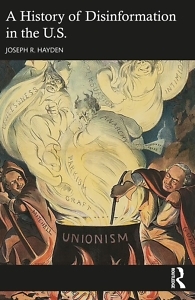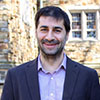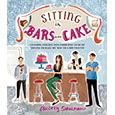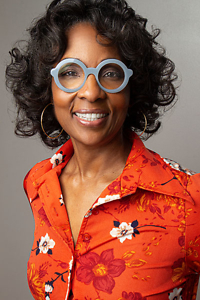Liar, Liar
Joseph Hayden explains the long history of disinformation in American politics and journalism
In 2016, PolitiFact identified “fake news” as its lie of the year. It was no accident that 2016 was an election year. As Joseph Hayden explains in A History of Disinformation in the U.S., the media has perpetrated periodic lies on issues that shape the evolution of American democracy.
 Hayden is a professor in the Department of Journalism and Strategic Media at the University of Memphis. He is the author of four previous books on journalism history, as well as writing guides on style and grammar. An award-winning teacher, he has a Ph.D. in history from Indiana University and has worked in television news as a writer, producer, and reporter. He answered questions via email from Chapter 16:
Hayden is a professor in the Department of Journalism and Strategic Media at the University of Memphis. He is the author of four previous books on journalism history, as well as writing guides on style and grammar. An award-winning teacher, he has a Ph.D. in history from Indiana University and has worked in television news as a writer, producer, and reporter. He answered questions via email from Chapter 16:
Chapter 16: How do you define “disinformation”? What makes it different from “misinformation”?
Joseph Hayden: Misinformation is the broader category — any kind of false information — whereas disinformation is a falsehood that’s peddled deliberately. A lie, in other words. But since it’s hard to pinpoint someone’s intentions, I use a broader definition to include examples in which public figures really ought to know that what they’re saying is untrue, when they’ve already been confronted with the falsity of a statement, when there’s ample evidence to disprove a claim. And I try to apply contemporary standards and sources, not those of today, to them.
Chapter 16: You mention that researching the life of Ida B. Wells inspired this book. How so?
Hayden: Wells was a pioneering investigative journalist who, in writing about the scourge of lynching, had to pry into the bloody details, examine the data, and come to conclusions based on the assembled evidence. One of those conclusions was that the vast majority of people who were lynched were probably innocent. Another was that many newspapers were often complicit in these gruesome murders. Yet she couldn’t combat lynching without challenging the lies the press told in encouraging such atrocities. So she compiled a detailed exposé on journalism itself. Wells isn’t usually included in the pantheon of Progressive-era muckrakers like Lincoln Steffens and Ida Tarbell, but she should be.
Anyway, it was her critique of mainstream American journalism that helped me appreciate the fact that this steady campaign of falsehoods told about Black people was longstanding and deeply embedded, not to mention lethal. It lasted generations and still persists today, zombie-like, in some racist cable TV “news” programming, on talk radio, and on the internet and social media. And throughout American history, there have been similar “bipartisan” lies told about many other groups of people — women, immigrants, poor people, etc.
Chapter 16: How have hoaxes and other big public lies evolved over the course of American history? Do you see more continuity or change?
 Hayden: Their main evolution has been adaptation to changing technologies. Thanks to Facebook, X, Instagram, and YouTube, hoaxes have a much better chance to go viral today than they did 50 years ago. These platforms’ algorithms incubate conspiracy-minded groups with scientific precision. They drive internet traffic and increase engagement exponentially. Hate and fear, many media scholars have pointed out, are “sticky.” These emotions trigger something primitive in our amygdala and get us to respond.
Hayden: Their main evolution has been adaptation to changing technologies. Thanks to Facebook, X, Instagram, and YouTube, hoaxes have a much better chance to go viral today than they did 50 years ago. These platforms’ algorithms incubate conspiracy-minded groups with scientific precision. They drive internet traffic and increase engagement exponentially. Hate and fear, many media scholars have pointed out, are “sticky.” These emotions trigger something primitive in our amygdala and get us to respond.
One other change has been a media landscape that’s crowded with content creators who compete with and distract from the old institutional gatekeepers. The old information sheriffs weren’t perfect, had their biases, made their mistakes, and were slow. But in that ecosphere, they probably minimized some of the more outlandish conspiracy theories that we see flourishing today.
Chapter 16: We live in an age rife with conspiracy theories. Why do conspiracy theories flourish? What conditions foster their proliferation?
Hayden: Disinformation is usually a product of thievery, zealotry, or bigotry — sometimes all three. Professional liars like to try to profit from what they’re doing. They’re out to gain power, attention, or advantage. And typically they revel in and weaponize hate. In fact, one of the things you see with QAnon or Alex Jones’ Newtown theories or the so-called “immigrant crime wave” (a complete fiction) is that scapegoats are often key ingredients in spreading falsehoods. Conspiracy lovers need a villain. So saying that immigrants or gay people or deep-state bureaucrats are behind some scheme will usually attract more true believers. These conspiracy theories almost never make sense, and their adherents are usually impervious to fact-checking. But that’s because it’s not about information; it’s about community. They want to belong to something that gives their lives meaning. Hate and fear can provide cohesion.
Chapter 16: How, as a society, can we combat disinformation? What lessons can we learn from history?
Hayden: All of us have a duty to challenge disinformation. Journalists need to think carefully about what they give a platform to, about which stories deserve oxygen and which don’t, about the dangers of myopically presenting a both-sides approach to issues. Some things don’t have two sides, while some have 40. Journalism means making choices and offering judgment. It always has. A popular meme these days is that the job of a journalist isn’t to report that one side says it’s raining while the other side says it’s not, but to go outside and actually check the damn weather.
Non-journalists have a crucial role to play, too. That means questioning friends who share misleading posts or deceptive headlines, calling or writing media outlets that promote phony stories or sensationalistic fare, complaining about office workplaces with Newsmax or Fox News on the lobby TV because those networks are anti-accountability and anti-facts. These disinformation spewers are trying to dupe you by stoking hate and fear. Don’t let them. So all of us have to push back at the con artists and BS peddlers. If we want to live in a democracy, that’s our responsibility as citizens.

Aram Goudsouzian is the Bizot Family Professor of History at the University of Memphis. His most recent book is The Men and the Moment: The Election of 1968 and the Rise of Partisan Politics in America.





